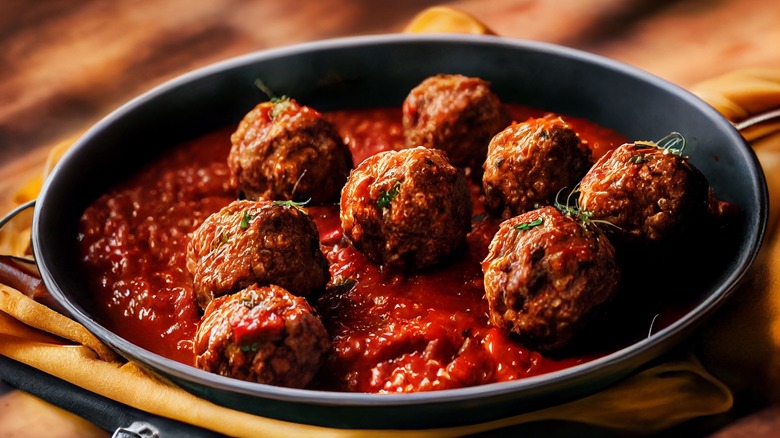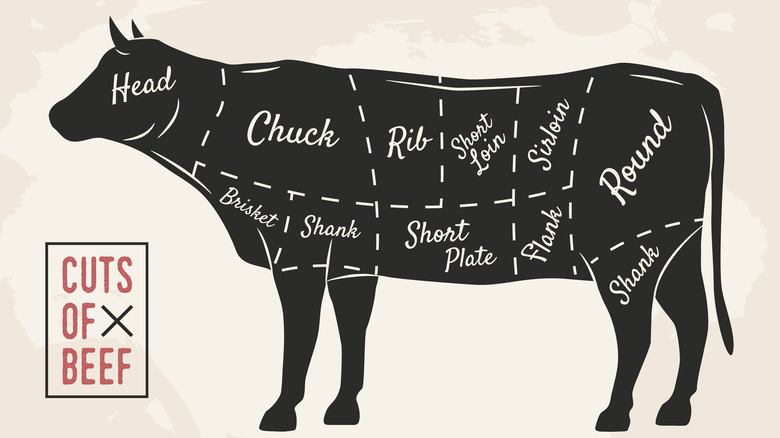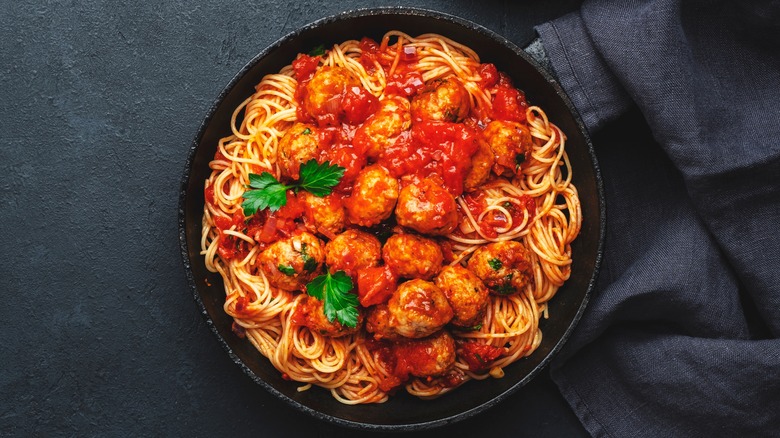The 2 Inexpensive Beef Cuts To Mash Up For Perfect Meatballs
As anyone who has recently taken a trip down the meat aisle knows, beef is more expensive than ever these days. Because of this, and also because of changing tastes, once obscure cuts of beef are becoming more popular. Hanger steak, for example, has gone from an affordable hidden gem to a sought-after cut.
So what is a discerning cook to do when setting out to make some meatballs without forking over a wad of cash? While there are plenty of tips you need when cooking meatballs, one thing that often gets overlooked is the cut of meat. Now, there are still plenty of affordable cuts of beef on the market, and meatballs present a great canvas for cheaper, collagen-rich parts. Shoulder clod and ranch steak are especially good choices for this task. Both cuts are packed with beefy flavor and fat that will make your meatballs rich and juicy. To understand why they perform well in meatballs, let's take a closer look at what these cuts are and where they're found on the cow.
What are shoulder clod and ranch steak?
Shoulder clod and ranch steak (which is itself a subsection of shoulder clod) come from the chuck area of the cow. The chuck is found in a cow's shoulders, an area that gets worked out regularly by the animal. This means that these cuts need to be cooked for longer periods or ground, due to their muscle fibers. When cooked low and slow, the muscle fibers in these cuts break down and their fat gets rendered out, resulting in delicious tender meat. For example, shoulder clod has a long history as a southern BBQ staple because it performs well during a long smoking process.
Muscled cuts like this also make great ground beef — while leaner cuts can become crumbly and dry if ground and cooked. Cuts like shoulder clod and ranch steak are much better options — which is why chuck is often used for hamburger. Grinding the shoulder will shred its thick muscle fibers, and result in a good ratio of fat and collagen. Both of these are crucial to making great meatballs.
Grind up shoulder clod and ranch steak for meatballs
No matter what kind of meatballs you're making, whether it's springy Swedish meatballs or Italian-American spicy meatballs, you want to grind up meat that will be moist and flavorful. Meatballs traditionally have other ingredients mixed in with the beef, ranging from other meat like pork to soaked bread or eggs. You need beef with a strong flavor that can hold its own against these ingredients. Fortunately, shoulder clod is known for its intense, beefy flavor.
You also need to find the right fat ratio for your meatballs. If you use a cut of beef with too little fat, the meatballs will dry out. If you use too much fat, they'll have an unpleasant texture and may taste oily. Shoulder clod has an ideal ratio of fat, which will give you a versatile ground beef.
There's also the price to consider. The meat industry data analytics company EMEAT currently estimates the cost of shoulder clod as just over $3 per pound at the time of publication. Better-known chuck cuts like short ribs average close to $5 to over almost $6 (via EMEAT).
It's important to note that shoulder clod is not sold everywhere. If you can't find it at the supermarket, you'll need to purchase it from a high-quality butcher or order it online. If you visit your local butcher, they should be able to grind the meat for you. Otherwise, this is a great time to break out that meat grinder and mince that meat yourself.



